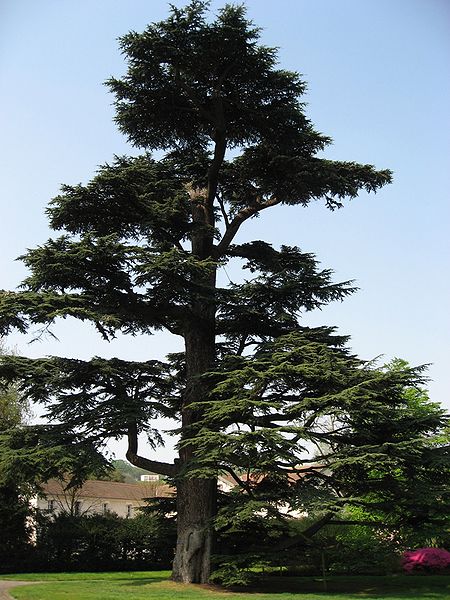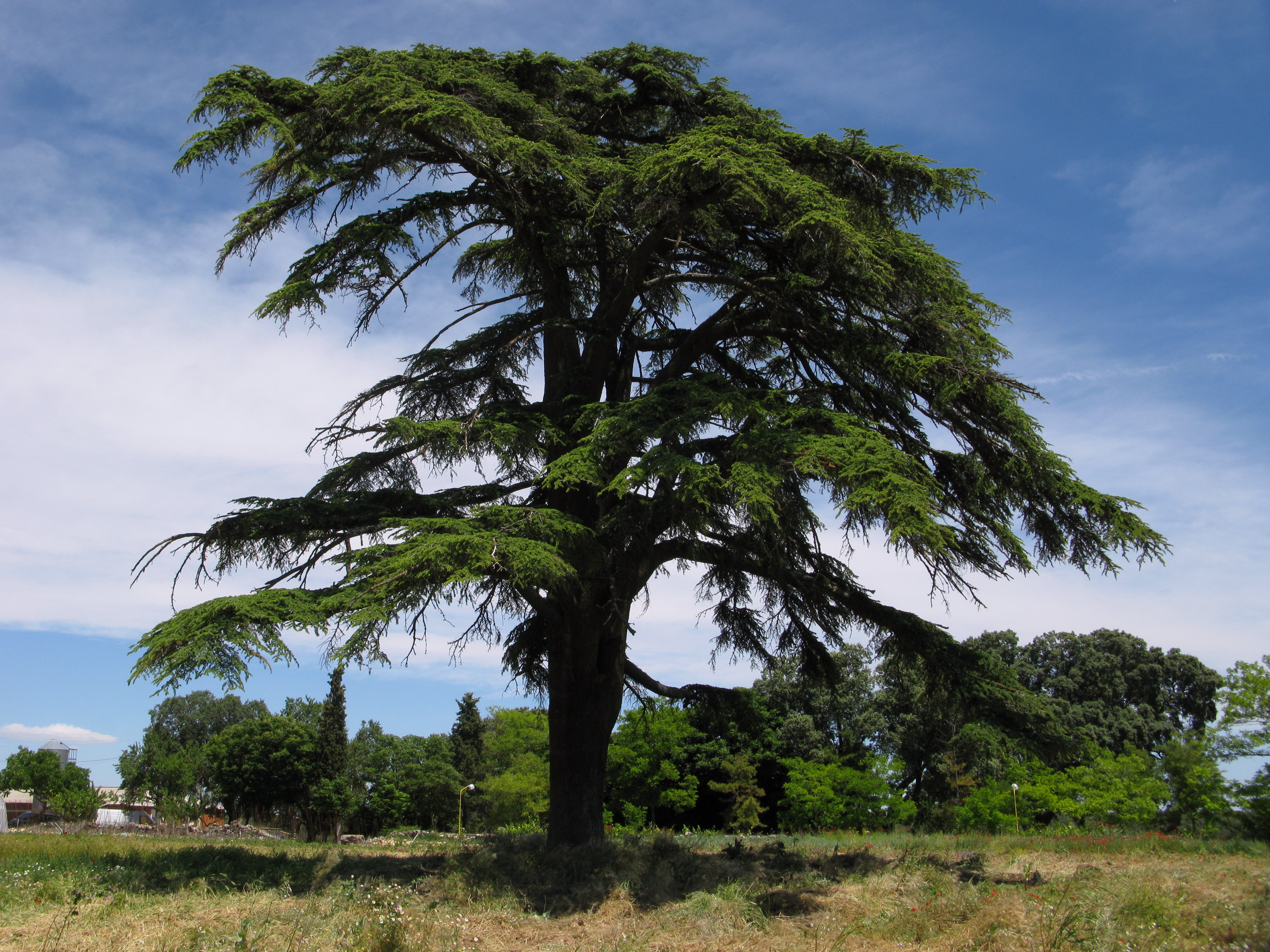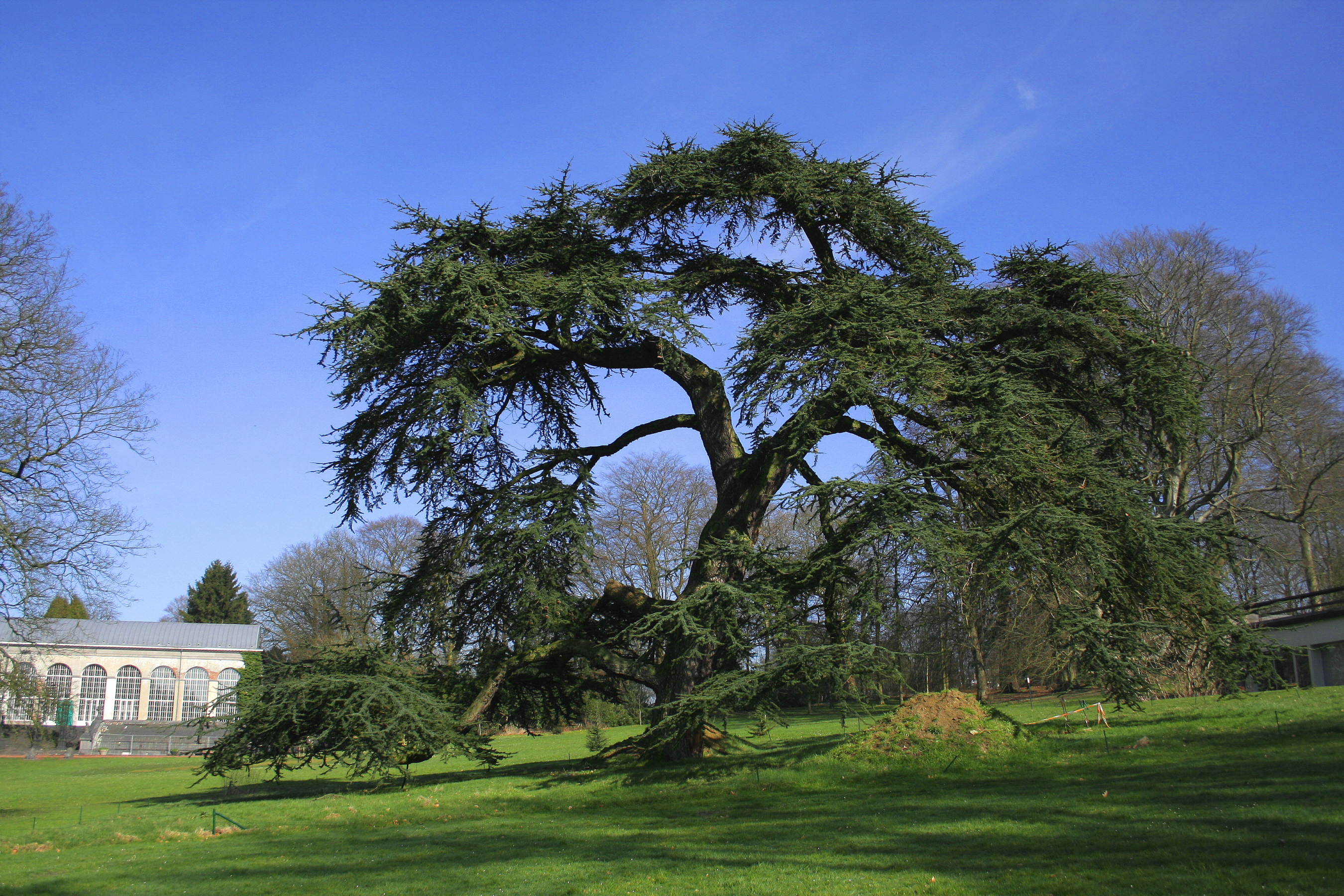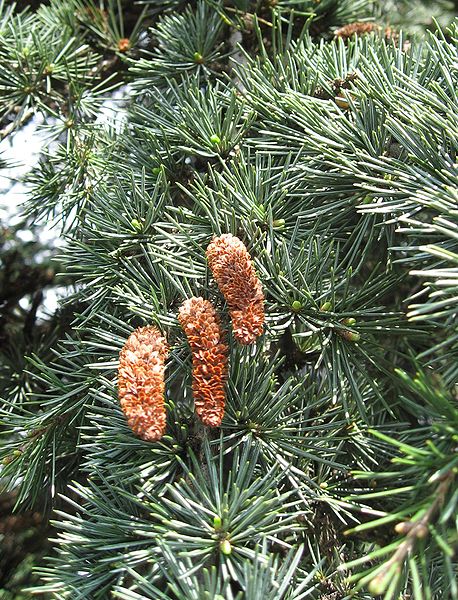Cedrus libani
Lebanon cedar (Cedrus libani ) Big tree in a park in Morlanwelz in Belgium
The Lebanon cedar (Cedrus libani, C. Syn libanotica ) is a species of the genus of the cedars (Cedrus ) in the pine family ( Pinaceae ).
Description
Habit
The Lebanon Cedar is an evergreen tree that reaches the plant height of 30 to 50 meters and can be over 1,000 years old. The diameter at breast height can be up to two meters. She trains both short shoots and long shoots. The slender tree crown is pyramidal in young trees, later it is rather bulky. There are sometimes even old trees with a pyramidal crown. The side shoots are almost at right angles from the main axis and are arranged spirally.
Foliage
The 1.5 to 3.5 inches long, about one millimeter thick leaves (needles) grow individually to the long shoots to short shoots in clumps 10 to 15 needles. Your outline is flattened square with stomata on all four sides. In cross-section two resin passages can be seen extending around the edge. The needles remain between three and six years on the tree.
Bark
The bark of young trees is smooth and gray colored green. The bark of old trees along cracked and gray to dark gray. It is 4.7 to 22.3 millimeters thick, can in extreme cases, but also account for up to 19% of the root volume.
Wood
The yellowish to reddish brown heartwood color stands out sharply from the relatively broad, pale yellow to pale red sapwood. It lacks normal resin canals, but it can traumatic resin canals occur. Freshly cut heartwood smells very aromatic. The density of air- dried wood with a moisture content of 15% is approximately 0.565 g / cm ³.
Flowers, cones and seeds
The Lebanon cedar is monoecious getrenntgeschlechtig ( monoecious ) and is reached puberty at around 30 years. The 3 to 5 -inch-long male cones are seen in June and in August yellowish stain. They are found singly standing on the tips of four - to five-year short shoots. The approximately 8 mm long, bluish- green female cones appear only in September. They are perpendicular to the ends of short shoots. The small and thin seed scales remain open one to two months. The cones need after pollination in September-October than twelve months until maturity. The end of May / beginning of June, the still green cones 2 to 3 inches long. In November, the tire studs are resinous and 7 to 11 centimeters in length with a diameter of 4-6 cm. They are brownish gray to brownish, and the cone scales have a thin, dark red streaks. The shed center has a greenish- purple color. Zapf shape varies between cone, rollers, and obovate. The cones disintegrate in the following winter months and scatter their seeds here. The elongated triangular, slightly compressed seed is 12 to 18 millimeters long, about 5.5 mm wide and 2.8 mm thick. The yellowish brown shiny seed wings are 2 to 2.5 inches long and as wide. The thousand grain weight is around 83 grams.
Distribution and location
The Lebanon cedar grows along the Mediterranean coast south and southwest Anatolia, Lebanon, whose symbol it is, and to the peaks of Jebel Aansariye in Syria. The three stocks are not geographically linked. In addition, there is an isolated occurrence in Turkey near the Black Sea. The total area of the cedar forests in Turkey is 600,000 hectares. The original natural distribution area is indicated in Lebanon with approximately 500,000 hectares, which is only 2,000 hectares by overexploitation today. The distribution area in Syria is estimated at about 1,000 acres. It is extremely drought resistant, but preferred locations with rainfall 590-1300 mm per year. There are calcareous soils preferred. They are found at altitudes 600-2100 m. ü. NN. It provides, among other things mixed forests with Cilician fir ( Abies cilicica ), pine (Pinus spp.) And juniper (Juniperus spp.) As Stinking juniper.
Pests
Parasitic fungi and bacteria provide for the Lebanon cedar no real hazard and the caterpillars of the butterfly Acleris undulana eat the needles of the cedar of Lebanon and can cause defoliation in outbreaks. As an important secondary pests of pine bark beetle Small ( Crypturgus cinereus ), Orthotomicus erosus and Melanophila be called delagrangei. They occur on trees that Halli mesh ( Armillaria ) or root sponges ( Heterobasidion ) were infested. As seed pests are squirrels (Sciurus ) and jewel wasps of the superfamily Chalcidoidea mentioned.
Forest fires represent no great danger, because most densely bonded leaf litter of cedar forests allows only small smoldering fires.
Use
The cedar of Lebanon is one of the most widely used tree species. The beautiful, durable and easy to work with wood of Lebanon cedar has been used for nearly 5,000 years. In ancient times it was used to the palace and temple. It was also a popular wood for ship building and furniture manufacturing. Even today, the wood is a very popular construction, carpentry and furniture wood. It is also suitable for pulp production. Before the Turkish Forest Protection Act of 1935 went into effect, was obtained from cedar pine oil. It was used in folk medicine as a remedy for skin diseases and as a means for treating wounds. The product obtained from the heartwood essential oil is sold as cedar oil.
The Lebanon cedar is a popular, almost hardy park tree in the temperate zones.
Cultural Significance
The flag of Lebanon and the coat of arms of Lebanon show in the center of a cedar.
For the Phoenicians, the cedar of Lebanon was regarded as queen of the plant kingdom. They used cedar among others on shipbuilding. The ancient Egyptians used cedar for its shipbuilding, being suspected that they imported them from Lebanon.
The cedar is mentioned several times in the Old Testament. In Psalm 92, A Song for the Sabbath day, it says: The righteous flourish like the palm tree, like the cedar of Lebanon, it blooms (Ps 92,13 EU). The Israelite King Solomon is said to have honored the cedars literary: he wrote poetry from the trees, from the cedar of Lebanon to the hyssop that grows out of the wall (1 Kings 5.13 EU). In addition, he bought it for the construction of the Temple (1 Kings. 5.20 EU and elsewhere ).
As a result of an already begun in Phoenician times overexploitation, there are only a few old trees in the Lebanon Mountains, six of the densest forest areas are located within the National Park Chouf Cedar Reserve, including the islands of forest in the villages Barouk and Maaser ech - Chouf have the largest number of old trees. There is a program for the conservation and afforestation.
The symbolism Rania Masri describes in detail in 1995 at a conference at MIT, are listed in an article in Europe: " About the importance and awareness of the cedar of Lebanon, as well as their treatment."
Also in Turkey reforestation of 300 km ² instead of annually.
Meanwhile, the symbolism is also taken up in Germany: the city of Marl planted on a proposal from the CIAG Marl under the 7th Abraham Festival 2007 such a tree to reaffirm the peace between the world cultures and religions.
System
The Lebanon cedar (Cedrus libani A.Rich, Syn. C. libanotica Link, C. libanitica ( Trew ) Pilgrim, C. libanensis Juss ex Mirb, C. cedrus Huth, C. patula K.Koch. .. ) is a small Asian Art
There are two varieties:
- Cedrus libani A. Rich. libani var
- Turkey - cedar ( Cedrus libani var stenocoma ( Black) Davis) it only grows in southwestern Anatolia.
The occurring in Cyprus Cyprus cedar (Cedrus brevifolia ( Hook. f ) Henry) and the North African Atlas cedar (Cedrus atlantica ( Endl. ) Manetti ) are closely related to the cedar of Lebanon and are considered by some botanists as a subspecies of Lebanon cedar referred ( Cedrus libani var brevifolia Hook f, Cedrus libani var atlantica Hort. ex Carr. ).









